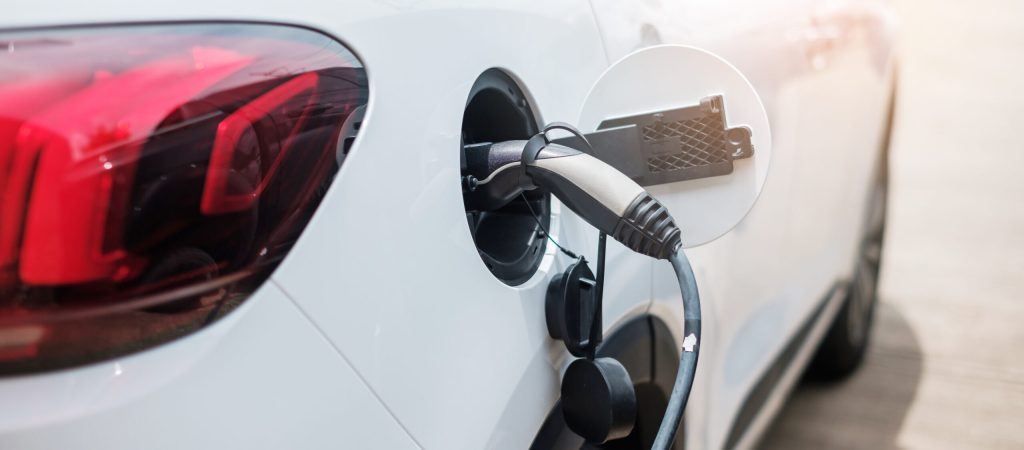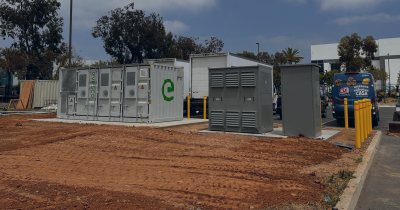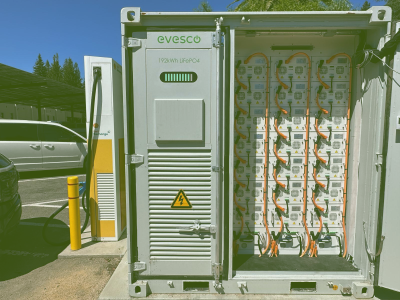The Comprehensive Guide to Level 2 EV Charging

This comprehensive guide on Level 2 charging for electric vehicles (EVs) covers everything from Level 2 charging speeds and charger types to EV charging incentives, ensuring you have all the knowledge you need to fully understand Level 2 EV charging.
LEVEL 2 CHARGERS: WHAT SETS THEM APART?
Level 2 chargers are a step up from Level 1 chargers, offering faster charging speeds using alternating current (AC) power. In the United States, they utilize a 208/240 volts input; in Europe, they utilize either a single-phase 230 volts input or a three-phase 400 volts input. Level 2 chargers are primarily designed for home, workplace, and public charging stations; they’re compatible with most electric vehicles available on the market and are the most common level charger installed globally. Level 2 chargers come in wall-mounted versions, which can also be attached to a pedestal, and versions with an all-in-one design.

AC VS. DC CHARGING
When discussing electric vehicle charging, it’s essential to understand the two types of electrical current used: alternating current (AC) and direct current (DC). Both currents play a crucial role in how long it takes to charge an EV and battery management in electric vehicles’ charging process.
Alternating Current (AC)
The electricity that comes from the grid and powers the outlets in your home or office is always AC. This electrical current is named after the way it flows, changing direction periodically. AC electricity can be transported over long distances efficiently, making it the global standard for power distribution. Level 2 EV charging inputs and outputs power in AC.
Direct Current (DC)
In contrast, batteries in EVs store direct current, named after its straight-line power flow. DC electricity is used within the power circuitry of electronic devices, powering them directly. When an electric vehicle is plugged into a Level 2 EV charging station, it receives AC power, which is then converted to DC electricity for use within the car by its onboard converter.

AC and DC Charging for Electric Vehicles
Electric vehicles undergo a power conversion process when charging with a Level 2 EV charger. The AC power supplied by the L2 charger is converted into DC electricity by the vehicle’s onboard converter before being stored in the battery. This DC power is then used to operate the vehicle.
Level 1 and Level 2 charging stations utilize AC power, which is converted to DC power by the vehicle’s onboard converter during the charging process. In contrast, Level 3 charging, also known as DC fast charging, directly supplies the battery with DC power. This is possible because the conversion from AC to DC occurs within the charging station, bypassing the vehicle’s onboard converter. This enables Level 3 chargers to deliver power quicker than Level 2.
By understanding the roles of AC and DC electricity in electric vehicle charging, you’ll better grasp the charging process and how the different levels of EV chargers operate to provide power to your vehicle.

The charging curves between AC and DC electric vehicle charging differ. With Level 2 EV charging (AC), the power delivery is steady as the onboard converter can only accept a relatively small amount of power at a time. This differs from DC fast charging, which delivers a high peak of power at the start before it slowly tapers down in power delivery as the battery slowly requests less power through the battery management system. You can see the difference in the charging curves in the below illustration.

HOW FAST IS LEVEL 2 EV CHARGING?
Charging speeds for Level 2 chargers range from 3 to 19.2 kilowatts (kW) in the United States and up to 22 kW in Europe, providing 10 to 75 miles (16 – 120 km) of range per hour of charging. The specific charging speed achieved depends on the charger’s power output and the vehicle’s onboard charging capabilities, including its charge acceptance rate. Roughly speaking, a Level 2 charger can be up to 19 times faster than a Level 1 charger. However, it isn’t as fast as Level 3 DC fast charging.
| Charging Level | Output Power Range | Estimated Charge time (40 kWh) | Estimated Range Per Hour of EV Charging | EV Connector Type | User Case |
| Level 2 (L2) | 3 kW – 22 kW (19.2 kW for USA) | 2 – 13 hours | 10 – 75 miles (16 – 120 km) | Type 1 – J1772 (USA and Japan) Type 2 – Mennekes (Europe) GB/T AC (China) | Home, workplace, overnight charging, hotels, long stay car parks, and public charging |
CHARGING TIMES FOR LEVEL 2 CHARGERS
The charging time for a Level 2 charger is influenced by the charger’s power output, the EV’s onboard charge acceptance rate, and the vehicle’s battery size. Many other variables can affect charging time, but here are some rough estimates based on an electric car that can accept the full charge power of the EV charger and adds 40 kWh of battery capacity (40 kWh is the average capacity of EV batteries).
| Level 2 Charger Output Power | Charge Time (hours) |
| 3 kW | 13.3 |
| 7 kW | 5.7 |
| 11 kW | 3.6 |
| 19.2 kW | 2.1 |
| 22 kW | 1.8 |
Please keep in mind these times will vary depending on the specific make and model of EV.
LEVEL 2 CHARGER TYPES: TETHERED VS. UNTETHERED
Level 2 electric vehicle chargers come in two main varieties: tethered and untethered. This section will delve into the key differences, merit and demerits, and other factors to consider when choosing between the two difference Level 2 charger types.

Tethered EV Chargers
Tethered chargers feature a permanently attached charging cable and connector, saving you from carrying a separate charging cable. They are easy to use and always ready for charging (when available). However, compatibility with all EVs depends on the connector type. Tethered Level 2 chargers are popular in North America.
Benefits of tethered EV chargers
- Convenience and ease of use – tethered chargers offer a hassle-free charging experience, as the charging cable and connector are always available and ready to use, eliminating the need to connect and disconnect charging cables manually. Ideal if you have forgotten your charging cable.
- Price transparency – the tethered EV charging cable is included in the overall price of the EV charger, so there is no need to buy separate charging cables to use it.
Things to consider with tethered EV chargers
- Limited by length: The manufacturer supplies the EV charging cable, which limits its length. If you need a longer cable, you must specify it at the point of order, usually at an additional cost.
- Larger space requirements: The attached cable increases the space needed to manage it properly. You may need to purchase additional cable management accessories to keep cables organized and tidy.
- Theft risk: Criminals sometimes cut tethered charging cables for their scrap value.
- Wear and tear: Tethered cables experience wear and tear and may require replacement over time.
Untethered EV Chargers
Untethered EV chargers do not have a permanently attached charging cable or connector. Instead, users must supply their own charging cable, which can be connected and disconnected via a socket in the EV charger. Untethered Level 2 chargers are popular throughout Europe.
Benefits of untethered EV chargers
- Easier to maintain – untethered chargers are smaller and tidier as they do not include the charging cable. Without the charging cable attached, there are fewer elements to maintain and potentially need replacing in the future.
- Less expensive – as they do not include a charger cable, an untethered EV charger is generally less expensive to buy than its tethered equivalent.
- Less restricted – if you need a longer charging cable, you can buy one without replacing the whole charger. As charging technology develops, it also allows for the use of upgraded charging cables in the future.
Things to consider with untethered EV chargers
- Less convenient – you have to physically attach the charging cable before charging and detach it once charging has finished, an extra step that isn’t needed for a tethered version.
- Not for everyone – if someone hasn’t got their charging cable or has forgotten it, they can not use the EV charger.
LEVEL 2 CHARGING CONNECTORS AND PLUGS
Different EV charging connectors and plug types are used in various regions across the globe. Four connectors and plugs are used mainly for Level 2 charging.
Type 1 (J1772)
The Type 1 connector and plug (the J Plug) is a charging standard used mainly in North America and Japan. It can deliver up to a 19.2 kW EV charger with 80 amps utilizing a single-phase 240-volt input. Almost every battery electric car and plug-in hybrid vehicle in North America, with the exception of Tesla, uses the Type 1 J1772 connector and plug.

Type 2 (Mennekes)
The Type 2 connector and plug, or Mennekes, is a charging standard used in Europe, Australia, and parts of the Middle East and Africa. It can deliver up to 7.6 kW with 32 amps at single-phase 230-volt and 22 kW with 32 amps utilizing a three-phase 400-volt input.

GB/T (AC)
GB/T is the EV connector and plug for AC electric vehicle charging in China. It can provide up to 7.4 kW of power output with a single-phase input. It looks similar to the Type 2 connector used in Europe. However, the wiring configuration inside the cable is entirely different, and as such, they are incompatible.

NACS (North American Charging Standard)
The NACS is a charging standard developed by Tesla for use in North America. It was previously named the Tesla Super Charger connector. It can provide both AC and DC charging to a Tesla model vehicle. The AC version classed as Level 2 can deliver up to 48 Amps on a single-phase 240-volt input.

IDEAL LOCATIONS FOR INSTALLING LEVEL 2 CHARGERS
Level 2 chargers offer the versatility to function efficiently in various locations, ensuring convenience and accessibility for EV users. Here are the ideal places for installing Level 2 chargers:
Home
Installing Level 2 chargers at home is perfect for overnight charging. They can provide a good range for daily commuting and regular short journeys, offering convenience and flexibility for homeowners.
Workplaces
Workplaces serve as strategic locations for Level 2 chargers. These chargers allow employees to recharge their EVs during work hours, making adopting electric vehicles more feasible and beneficial for staff. Installing EV chargers at your workplace will also help to attract and retain environmentally conscious staff and can be used as an employee benefit or perk.
Public Charging Stations
Installing Level 2 chargers at public charging stations provides accessible charging solutions for EV drivers away from home or work. These locations can include community centers, parks, event venues, leisure centers, and roadside rest stops. Public charging stations are essential for EV users who cannot have an EV charger at home due to no off-street parking.
Commercial Properties
Commercial properties such as retail parks, restaurants, long-stay car parks, and hotels are excellent locations for Level 2 chargers. They support EV fleets, encourage customers to spend more time on the premises and potentially money while their vehicles charge, and convey a commitment to sustainability.
In summary, Level 2 chargers can be strategically placed in various locations to support the widespread use of electric vehicles and meet the changing needs of different user groups. By carefully selecting installation locations, Level 2 charging can seamlessly integrate into people’s lives and daily routines, making EV ownership a more attractive option.
INCENTIVES FOR INSTALLING LEVEL 2 CHARGERS
Many countries, states, and local governments offer financial incentives to encourage the adoption of electric vehicles and in particular EV charging infrastructure. Incentives for EV charging include tax credits, rebates, and grants. In the United States there are various Level 2 and DC fast charger incentives by state including rebates from utility companies.
Level 2 charging is a practical, efficient, and convenient method for charging electric vehicles at home, work, or public locations. By understanding the various aspects of Level 2 charging, such as charging speeds, connectors, and available incentives, you’ll be well-equipped to decide whether installing Level 2 charging stations is the right choice for you.



